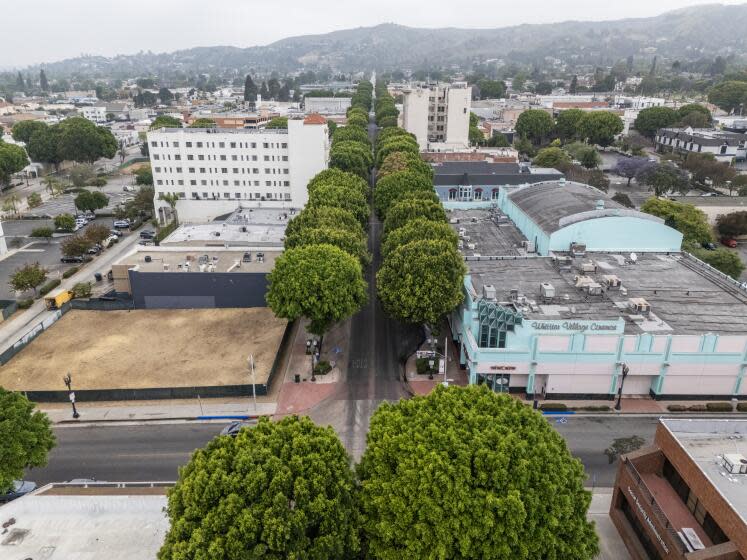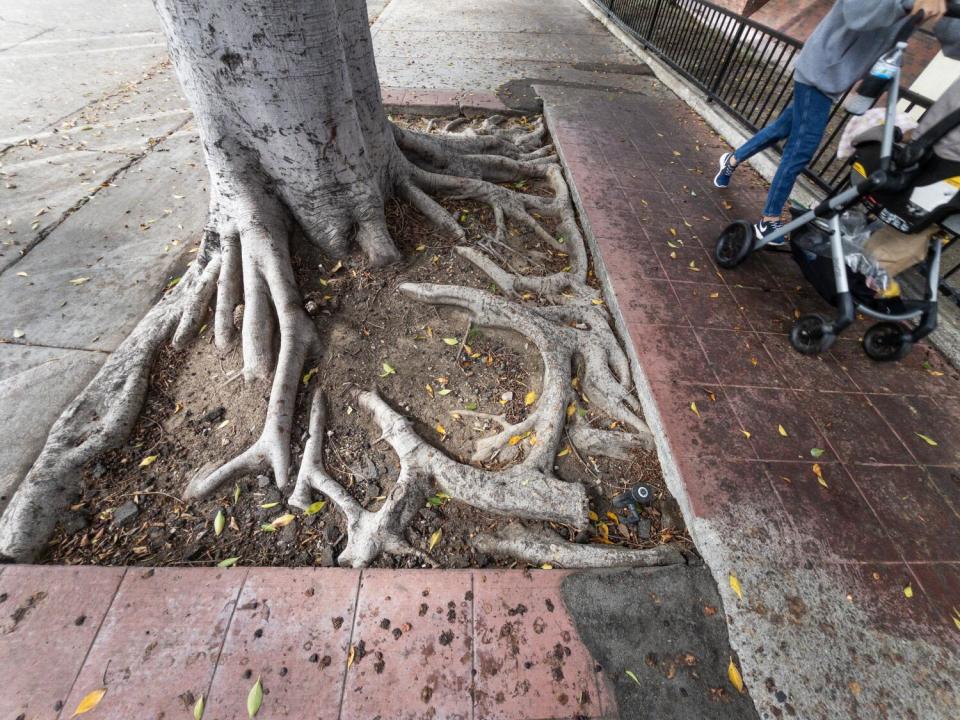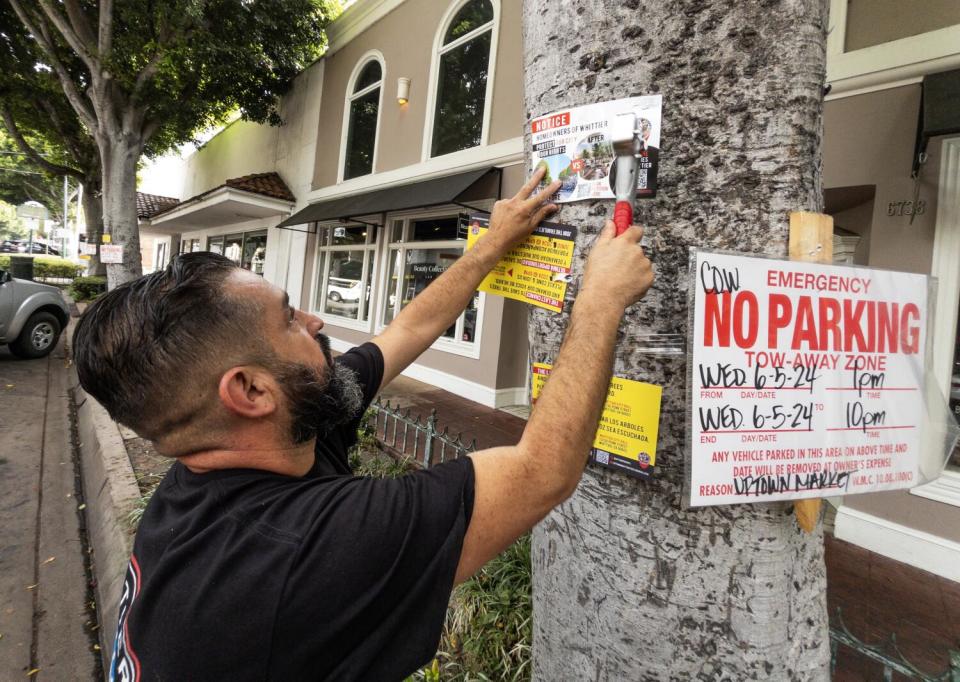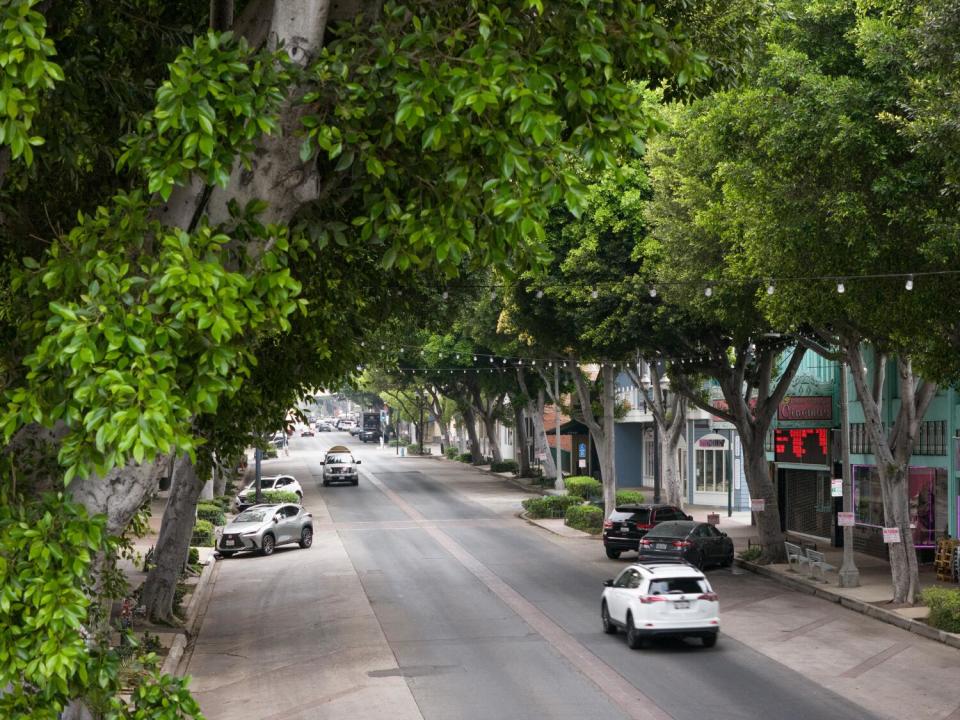Whittier to remove more than 80 ficus trees in bid to boost business

Whittier will move forward with razing 83 ficus trees as part of a redesign of its commercial center despite an outpouring of opposition to the plan.
On Tuesday night, City Council members voted 3 to 1 to proceed with a $20-million redevelopment project in Uptown Whittier that requires the removal of all the ficus trees in the three-block project area.
The decision followed months of public outcry over the fate of the trees after the mid-December approval of the Greenleaf Promenade.
The project is touted as a means to make the area more pedestrian-friendly and infuse financial life into the area, but some residents believe sacrificing the towering trees — with their cooling canopy and majestic appearance — isn't a reasonable trade-off.
City leaders said they ultimately saw promise in the refresh, while pointing to potential health and safety issues posed by the trees.
"I'm looking forward to revitalize Uptown with new trees, new architecture, new lighting, new pavement — that I think we can all be proud of," Councilmember Fernando Dutra said before voting in support of the project.
Mary Ann Pacheco, a recent addition to the council, cast the lone opposition vote. She said the plan suffered from bad optics, which could potentially be resolved by overhauling the planning process.
"The perception in the city is that it was done wrong, and that it was done for the wrong reasons," she said. "I'm not going to say it was, but until that real issue is dealt with the trees are going to continue to be — quote — the problem."
Read more: Whittier planned to cut down more than 80 ficus trees. Then came the outrage
The debate over the trees has divided the community, pitting some business owners against residents — and against one another. There have even been calls to boycott businesses seen as condoning their removal.
Some see the trees as synonymous with the character of the quiet community nestled in eastern Los Angeles County, and praise them for providing shade and gobbling greenhouse gases in a warming world.
Others blame the nonnative trees for lifting sidewalks and clogging sewer lines with their roots, or are willing to sacrifice the trees to break ground on a project they believe will bring economic vitality.
More than 40 speakers passionately shared their perspective during public comments at the recent meeting, with almost all opposed to removing the trees.
Helen Rahder, executive director of the Whittier Conservancy, called the plan "absurd" during her public comments.
"It's in your hands, and you have the ability to do it: revise the plan to include the trees," she said. "You have to go back to the drawing board on this. The community is not going to accept this."

Tensions flared several times at the meeting, which stretched to roughly four hours. Audience members at times hurled insults at officials and twice Mayor Pro Temp Cathy Warner ordered breaks amid the din.
Someone called out as the meeting adjourned, "You guys suck!"
Several council members expressed disappointment in the hostile tone of the debate — both in and out of City Hall — during their comments.
At the meeting, council members approved modifications to the project, including replacing trees slated for removal with larger trees than previously envisioned, as well as adding more umbrella structures to cover the sidewalk. The changes appeared to respond to concerns about the possible loss of canopy and shade, and could boost carbon sequestration.
According to a consultant hired by the city, there would be a significant drop in carbon sequestration the first year after the current canopy was replaced, with the level expected to break even in 24 years based on the initial plan.
"The break-even year would come sooner under this scenario with the larger trees," said Alan Ashimine of Michael Baker International, which provided environmental consultation. "A larger tree planted would mature more quickly and sequester more carbon earlier in the lifespan of the project."
City officials also explored options to phase in the project over time and answered more than 50 questions posed in public comments, including about legal liability posed by tree hazards, environmental documentation and historic streetlights.
"We will NOT give up!" resident Conny McCormack said in a text message the day after the meeting. McCormack, who was among those leading the opposition to the tree removal, suggested a lawsuit might be in the works.
Since residents became aware of the plan to rip out the trees, they have turned out en masse at meetings, held rallies and circulated a petition to protest removing the trees all at once to make way for the Greenleaf Promenade.

City leaders took heed. The recent "study session" focused on the trees followed two more after the outcry.
According to city officials, construction elements, such as required grading, make it impossible to save any of the ficus trees.
At the meeting, City Manager Brian Saeki said the city could not remove every other tree because of tree protection zones, or areas around the trees where "no construction can happen ... without jeopardizing the health of those trees."
Some other types of trees that line the street may be salvaged, officials said.
Read more: L.A.’s palm trees are dying and it’s changing the city’s famous skyline
One point of broad agreement is that Uptown Whittier, considered the heart of the city, could use a little love. Its last update was in the 1980s, including renovations after the 1987 Whittier Narrows earthquake that badly damaged the area.
The envisioned promenade stretches from Wardman Street to Hadley Street, along the aptly named Greenleaf Avenue, and includes wider sidewalks, outdoor dining, gathering spaces, street furniture and decorative lighting.
City officials “are committed to revitalizing Uptown Whittier into a thriving, walkable and pedestrian-friendly area for generations of residents to enjoy,” Saeki said in a statement last month. To realize the “long-held vision,” he said, it’s necessary to remove certain trees in the project area.
“We understand the community’s concerns, appreciate the feedback we’ve received,” Saeki said, adding that the city will plant larger replacement trees “wherever possible,” as well as add 39,000 square feet of understory landscaping and 18,000 square feet of new park space.
A similar but smaller pilot project was approved in 2019 but was scuttled by the pandemic, according to city officials. Estimated to cost $3.8 million, the one-block Gardens of Uptown differed in a way some see as crucial: It preserved clusters of ficus trees.
Over the next few years, city officials said, the project morphed and expanded, partly in response to shifting preferences born out of the pandemic. Greenleaf Promenade costs roughly five times that of the pilot project.

Through it all, Uptown Whittier has retained a small-town vibe. Greenleaf Avenue is lined with mom-and-pop shops, such as the more-than-70-years-running Lovell’s Records, interspersed with newer establishments, such as La Sexy Michelada, a bar and restaurant.
Today, the ficus trees stirring the controversy — believed to date to the late 1960s — create a shaded canopy across the avenue. Some of their benefits and drawbacks are on clear display. Step outside their outstretched branches on a warm day and prepare to be lashed by the sun. But stroll the sidewalk under them when they’re dropping berries, and expect to step in organic muck.

It’s not just Whittier wrestling with ficus ambivalence.
Beverly Hills clear-cut more than 50 ficus trees as part of a sidewalk renovation project before a judge ordered the city to stop via a preliminary injunction. After the ruling, the city opted to complete an environmental impact report for the project, which is still underway.
In 2018, Pasadena city officials held a meeting to gather community input on whether to keep planting ficus trees, as well as how they affected Green Street. In March last year, the volunteer group Pasadena Beautiful Foundation reported planting 30 ficus trees on the street.
This story originally appeared in Los Angeles Times.


